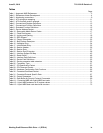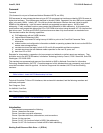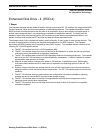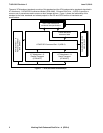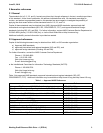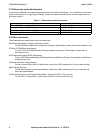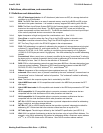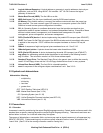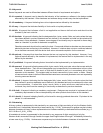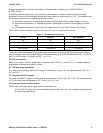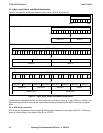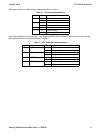June 23, 2010 T13/2132-D Revision 3
Working Draft Enhanced Disk Drive - 4 (EDD-4) 5
3 Definitions, abbreviations, and conventions
3.1 Definitions and abbreviations
3.1.1 ATA (AT Attachment) device: An AT Attachment (also known as IDE) is a storage device that
conforms to an ATA standard.
3.1.2 BDA: The BIOS Data Area is an area of reserved memory used by the BIOS and OS to store
data about the system hardware. It is located at memory segment 40h starting with 40h:00h.
3.1.3 BIOS: The Basic Input/Output System (BIOS) is the firmware stored in non-volatile (NV) memory
located on the computer's main board. The BIOS executes POST to test and initialize the
system components and then loads the OS. The BIOS also handles the low-level Input/Output
to the various peripheral devices connected to the computer.
3.1.4 byte: A sequence of eight contiguous bits considered as a unit. See 3.3.10.
3.1.5 Carry Clear: a condition where the Carry Flag in the ELAGS register is cleared to zero.
3.1.6 Carry Set: a condition where the Carry Flag in the EFLAGS register is set to one.
3.1.7 CF: The Carry Flag is a bit in the EFLAGS register in the microprocessor.
3.1.8 CHS: CHS addressing is a method of addressing the contents of a storage device using logical
cylinders (C), logical heads (H), and logical sectors (S). This method of addressing allows a
maximum C=16,383, H=16, S=63, resulting in a maximum device capacity of 8.4 gigabytes
(16,383 16 63 512 bytes per sector 8.4 gigabytes). See LBA addressing for another addressing
method.
3.1.9 Conventional: When a word, term, or phrase is modified by the word "conventional" it refers to
the legacy style, or method of operation that is limited to addressing ATA devices that have a 528
MB capacity or less. See 3.2.10xxx for the definition of "Enhanced".
3.1.10 DOS: DOS is a disk operating system that uses the system BIOS as a firmware abstraction layer
to access system hardware. Examples of DOS based operating systems include MS-DOS
®
,
DR-DOS, PC-DOS, Free DOS, Windows
®
3.11, and Windows
®
95.
3.1.11 DWord: A sequence of four contiguous bytes considered as a unit. See 3.3.10.
3.1.12 enhanced: When a word, term, or phrase is modified by the word "enhanced" it means there is a
"conventional" and an "enhanced" method of operation. The "enhanced" method is defined by
this standard.
3.1.13 Host: The Host is the computer system that is controlled by the BIOS.
3.1.14 Hybrid MBR boot code: IA-32 compatible code located in the MBR that processes the GPT
disk layout.
3.1.15 Hybrid VBR boot code: IA-32 compatible code located in the VBR that processes the GPT disk
layout.
3.1.16 IA-32 compatible: IA-32 compatible refers to computer processor architectures that are
compatible with the Intel Architecture 32-bit wide processor and data bus.
3.1.17 IA-64 compatible: IA-64 compatible refers to computer processor architectures that are
compatible with the Intel Architecture 64-bit wide processor and data bus.
3.1.18 INT 13h: A BIOS interrupt service that provides a protocol independent method for addressing
floppy, hard drive, and other storage devices.
3.1.19 INT 40h: INT 40h is a BIOS interrupt service that provides a protocol independent method for
addressing INT 13h devices that have a device number less than or equal to 7Fh.
3.1.20 GPT disk layout: The disk layout defined by the Unified EFI specification (see UEFI-2.3).
3.1.21 LBA: LBA is a method of addressing a device that involves using a Logical Block Address. For
example, using 28-bit addressing, this method of addressing allows a maximum sector address
of 2
28
-1, or 137.4 GB of data on an ATA device. See CHS for another address method.



